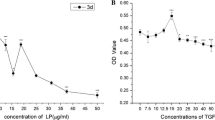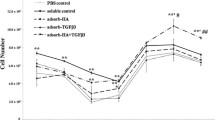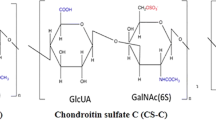Abstract
Objective
Although chondroprotective activities have been documented for polysaccharides, the potential target of different polysaccharide may differ. The study was aimed to explore the effect of glucan HBP-A in chondrocyte monolayer culture and chondrocytes-alginate hydrogel constructs in vivo, especially on the expression of type II collagen.
Methods
Chondrocytes isolated from rabbit articular cartilage were cultured and verified by immunocytochemical staining of type II collagen. Chondrocyte viability was assessed after being treated with HBP-A in different concentrations. Morphological status of chondrocytes-alginate hydrogel constructs in vitro was observed by scanning electron microscope (SEM). The constructs were treated with HBP-A and then injected to nude mice subcutaneously. Six weeks after transplantation, the specimens were observed through transmission electron microscopy (TEM). The mRNA expressions of disintegrin and metalloproteinase with thrombospondin motifs 5 (ADAMTs-5), aggrecan and type II collagen in both monolayer culture and constructs were determined by real time polymerase chain reaction (PCR). The expression of type II collagen and matrix metalloproteinases-3 (MMP-3) in chondrocyte monolayer culture was also tested through Western blot and enzyme linked immunosorbent assay (ELISA), respectively.
Results
MMP-3 secretion and ADAMTs-5 mRNA expression in vitro were inhibited by HBP-A at 0.3 mg/mL concentration. In morphological study, there were significant appearance of collagen in those constructs treated by HBP-A. Accordingly, in both chondrocyte monolayer culture and chondrocytes-alginate hydrogel constructs, the expression of type II collagen was increased significantly in HBP-A group when compared with control group (P<0.001).
Conclusions
The study documented that the potential pharmacological target of glucan HBP-A in chondrocytes monolayer culture and tissue engineered cartilage in vivo may be concerned with the inhibition of catabolic enzymes MMP-3, ADAMTs-5, and increasing of type II collagen expression.
Similar content being viewed by others
References
Kubo M, Ando K, Mimura T, Matsusue Y, Mori K. Chondroitin sulfate for the treatment of hip and knee osteoarthritis: current status and future trends. Life Sci 2009;85:477–483.
Monfort J, Pelletier JP, Garcia-Giralt N, Martel-Pelletier J. Biochemical basis of the effect of chondroitin sulphate on osteoarthritis articular tissues. Ann Rheum Dis 2008;67:735–740.
Feng W SY, Shen PZ. The study of Chinese medicine on the proliferation of chondrocytes in vitro by MTT method. Acta Univ Tradit Med Sin Pharmacol Shanghai (Chin) 2004;4:43–45.
Chan PS, Caron JP, Orth MW. Effect of glucosamine and chondroitin sulfate on regulation of gene expression of proteolytic enzymes and their inhibitors in interleukin-1-challenged bovine articular cartilage explants. Am J Vet Res 2005;66:1870–1876.
Huh JE, Baek YH, Lee JD, Choi DY, Park DS. Therapeutic effect of Siegesbeckia pubescens on cartilage protection in a rabbit collagenase-induced model of osteoarthritis. J Pharmacol Sci 2008;107:317–328.
Wu K WS, Huang L. In vitro effect of a traditional Chinese medicine formula-BYYNG on breast cancer cell line-4T1 for prevention of bone metastasis. Hong Kong J Orthopedics 2004;8:77.
Makihira S, Yan W, Murakami H, Furukawa M, Kawai T, Nikawa H, et al. Thyroid hormone enhances aggrecanase-2/ADAM-TS5 expression and proteoglycan degradation in growth plate cartilage. Endocrinology 2003;144:2480–2488.
Soman G, Yang X, Jiang H, Giardina S, Vyas V, Mitra G, et al. MTS dye based colorimetric CTLL-2 cell proliferation assay for product release and stability monitoring of interleukin-15: assay qualification, standardization and statistical analysis. J Immunol Methods 2009;348:83–94.
Konttinen YT, Ma J, Ruuttilal P, Hukkanen M, Santavirta S. Chondrocyte-mediated collagenolysis correlates with cartilage destruction grades in osteoarthritis. Clin Exp Rheumatol 2005;23:19–26.
Saito M, Takahashi KA, Arai Y, Inoue A, Sakao K, Tonomura H, et al. Intraarticular administration of platelet-rich plasma with biodegradable gelatin hydrogel microspheres prevents osteoarthritis progression in the rabbit knee. Clin Exp Rheumatol 2009;27:201–207.
Yang WD, Chen SJ, Mao TQ, Chen FL, Lei DL, Tao K, et al. A study of injectable tissue-engineered autologous cartilage. Chin J Dent Res 2000;3:10–15.
Dobratz EJ, Kim SW, Voglewede A, Park SS. Injectable cartilage: using alginate and human chondrocytes. Arch Facial Plast Surg 2009;11:40–47.
Yoon DM, Curtiss S, Reddi AH, Fisher JP. Addition of hyaluronic acid to alginate embedded chondrocytes interferes with insulin-like growth factor-1 signaling in vitro and in vivo. Tissue Eng Part A 2009;15:3449–3459.
Dudek KA, Lafont JE, Martinez-Sanchez A, Murphy CL. Type II collagen expression is regulated by tissue-specific miR-675 in human articular chondrocytes. J Biol Chem 2010;285:24381–24387.
Kishimoto H, Akagi M, Zushi S, Teramura T, Onodera Y, Sawamura T, et al. Induction of hypertrophic chondrocytelike phenotypes by oxidized LDL in cultured bovine articular chondrocytes through increase in oxidative stress. Osteoarthritis Cartilage 2010;18:1284–1290.
Temple-Wong MM, Bae WC, Chen MQ, Bugbee WD, Amiel D, Coutts RD, et al. Biomechanical, structural, and biochemical indices of degenerative and osteoarthritic deterioration of adult human articular cartilage of the femoral condyle. Osteoarthritis Cartilage 2009;17:1469–1476.
Pujol JP, Chadjichristos C, Legendre F, Bauge C, Beauchef G, Andriamanalijaona R, et al. Interleukin-1 and transforming growth factor-beta 1 as crucial factors in osteoarthritic cartilage metabolism. Connect Tissue Res 2008;49:293–297.
Hardingham T. Extracellular matrix and pathogenic mechanisms in osteoarthritis. Curr Rheumatol Rep 2008;10:30–36.
Song RH, Tortorella MD, Malfait AM, Alston JT, Yang Z, Arner EC, et al. Aggrecan degradation in human articular cartilage explants is mediated by both ADAMTS-4 and ADAMTS-5. Arthritis Rheum 2007;56:575–585.
Fosang AJ, Little CB. Drug insight: aggrecanases as therapeutic targets for osteoarthritis. Nat Clin Pract Rheumatol 2008;4:420–427.
Tchetina EV, Squires G, Poole AR. Increased type II collagen degradation and very early focal cartilage degeneration is associated with upregulation of chondrocyte differentiation related genes in early human articular cartilage lesions. J Rheumatol 2005;32:876–886.
Huang K, Wu LD. Aggrecanase and aggrecan degradation in osteoarthritis: a review. J Int Med Res 2008;36:1149–1160.
May M, Benghuzzi H, Tucci M, Mohamed A, Tan M, Norwood A. The role of glucosamine, chondroitin and thymoquinone on the viability and proliferation of a HTB-93 rheumatoid arthritis cell model. Biomed Sci Instrum 2006;42:338–343.
Verbruggen G. Chondroprotective drugs in degenerative joint diseases. Rheumatology (Oxford) 2006;45:129–138.
Gomis A, Miralles A, Schmidt RF, Belmonte C. Intraarticular injections of hyaluronan solutions of different elastoviscosity reduce nociceptive nerve activity in a model of osteoarthritic knee joint of the guinea pig. Osteoarthritis Cartilage 2009;17:798–804.
Author information
Authors and Affiliations
Corresponding author
Additional information
Supported by the National Natural Science Foundation of China (No. 30300459, 81072830), Shanghai Leading Academic Discipline Project (No. T0303) and the Shanghai Youth Phospherus Project (No. 08QA14063)
Rights and permissions
About this article
Cite this article
Cao, Yl., Liu, T., Pang, J. et al. Glucan HBP-A increase type II collagen expression of chondrocytes in vitro and tissue engineered cartilage in vivo . Chin. J. Integr. Med. 21, 196–203 (2015). https://doi.org/10.1007/s11655-013-1511-x
Received:
Published:
Issue Date:
DOI: https://doi.org/10.1007/s11655-013-1511-x




